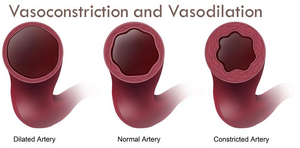Vasodilation: Difference between revisions
>Josikins adding useful diagram |
>Josikins adding useful diagram |
(No difference)
| |
Revision as of 01:25, 22 March 2018

Vasodilation refers to the widening of blood vessels resulting from the relaxation of smooth muscle cells within the vessel walls (in particular in the large veins, large arteries, and smaller arterioles). In essence, the process is the opposite of vasoconstriction, which is the narrowing of blood vessels. The primary function of vasodilation is to increase blood flow in the body to tissues that need it most.
THC and other cannabinoids cause vasodilation by decreasing blood pressure; this dilates the blood vessels and increases blood flow throughout the body. The arteries in the eyeball expand from the decreased blood pressure and this often results in a bloodshot red eye effect and relief from glaucoma.[1][2]
Psychoactive substances
Compounds within our psychoactive substance index which may cause this effect include:
- 5F-AKB48
- 5F-PB-22
- APICA
- Cannabis
- GBL
- GHB
- Harmala alkaloid
- JWH-018
- JWH-073
- Myristicin
- Poppers
- STS-135
- THJ-018
- THJ-2201
Experience reports
Anecdotal reports which describe this effect within our experience index include:
See also
- Responsible use
- Subjective effects index
- Psychedelics - Subjective effects
- Dissociatives - Subjective effects
- Deliriants - Subjective effects
External links
References
- ↑ Cardiovascular Effects of Cannabis | http://www.idmu.co.uk/canncardio.htm
- ↑ Is Marijuana an Effective Treatment for Glaucoma? | http://medicalmarijuana.procon.org/view.answers.php?questionID=000140